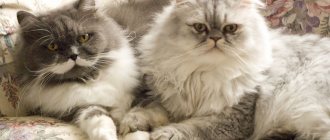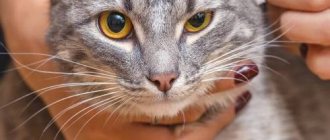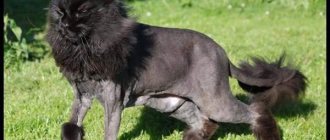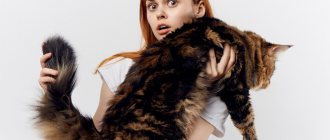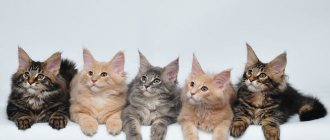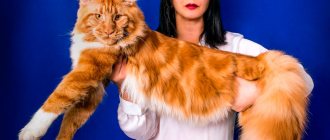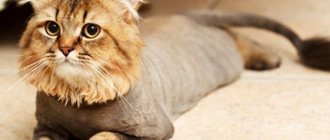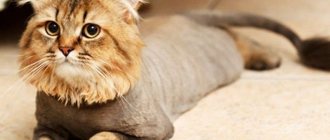How to properly care for Maine Coon fur
Maine Coons are long-haired cats that, moreover, shed regularly and profusely, so you should never leave their fur without proper care.
Tangles can quickly form, which can only be cut off, and the wool itself will lose its appearance.
It is important to know how to comb your Maine Coon so that he looks good and the process itself is painless.
Features of training a Maine Coon to comb
These cats begin to shed from childhood, when their baby fur changes to adult fur.
That is why it is necessary to accustom a Maine Coon to combing from childhood, so that the kitten learns that this is a necessary procedure and then does not have to figure out how to comb out the Maine Coon’s tangles.
Usually the first shedding begins when the kitten is about six months old or a little older, and can continue even until he is two years old.
This is a normal and natural process, but it means that now you will have to brush it at least once a week.
For those who want to know how to brush a Maine Coon at home, it is important to remember that the kitten must be taught to perceive the process as pleasant.
Then the adult animal will know that it will be released, and will calmly react to the owner’s desire to comb it.
Normal seasonal shedding lasts from September to November, and then from February to April, but for indoor cats this schedule often gets disrupted.
In addition, one hair lives on them for no more than a month, which means they are constantly being replaced and renewed.
Your Maine Coon will have to be brushed constantly, so he should enjoy the process. Then you won’t have to decide how to comb your Maine Coon if he’s against it. It may be worth offering him a treat if you can't cope otherwise.
Another option is to use a special mitten so that the animal thinks that it is just being petted.
Why are they?
Cat combs for combing fur were invented by man to keep a pet’s coat impeccably clean, beautiful and in order. And if a cat is taught from childhood to the procedure of combing (and also washing his eyes and cleaning his ears) with affection and play, then he will really love this care. And it will even ask itself!
But if you don’t teach it, then don’t be surprised. such a reaction:
This “brush” will “comb” anyone’s hair
How to properly comb a Maine Coon
In addition to the fact that combing saves you from problems with shedding, it also allows you to maintain the animal’s coat in a beautiful form and avoid the appearance of tangles.
Massage from the movements of the brush awakens the hair follicles.
There is another reason to brush your cat - the more hair removed from the brush, the less he will be able to lick off himself when he washes himself.
A Maine Coon that does not like to be brushed may suffer from hair buildup in the intestines.
Maximum attention should be paid to his belly and pants - it is on them that the thin fluffy fur most often forms tangles.
At the same time, it is important to remember that a cat’s stomach is a vulnerable place, and approach combing it with great care.
Any discomfort can scare the animal away. What makes the task especially difficult is that the fur on his belly grows in different directions and is easy to pull. So there is no need to rush here under any circumstances.
The rest of the body is much easier to deal with. You need to move in the direction from head to tail, according to the growth of the fur. The collar is combed in reverse.
You need to know what is the best way to comb a Maine Coon.
The process looks like this:
How to choose a brush for combing
The answer to the question of which comb is best to brush your Maine Coon is quite simple. But first of all, you need to know what not to do.
In order to cope with a Maine Coon, you will not need:
When choosing which comb to comb your Maine Coon, it is better to avoid brushes with plastic handles - they accumulate static, and cats don’t like that.
Wooden handles will be less problematic, but such brushes wear out quickly and have to be replaced.
To care for your fur you only need a few items:
Instead of scissors, you can also use a special comb with a sharp edge, which allows you to quickly deal with the problem right in the process of combing. On the other hand, you need to use it carefully.
The animal's skin can be easily touched and injured, especially if it is actively moving and unhappy with the process.
Therefore, this option is suitable only for those Maine Coons who sit quietly while their owners take care of their hair.
If your pet is shedding heavily, you can run a rubber brush with short, triangular teeth through its fur before using a wide-tooth comb.
It will collect fallen hairs from the very surface. It can also be used at the very end to give shape to the combed wool.
To care for your Maine Coon's coat, you can also use various care products: anti-tangle sprays and powder, detangling shampoos and others.
Source
For short-haired representatives
Plush and thick wool, for example, the British shed heavily, for care you need:
- metal comb with frequent thick teeth;
- at the end of the procedure, use a natural brush (or rubber mitten).
- comb-comb;
- a brush with sparsely spaced bristles.
Bengal, toyger, ocicat should be combed 2-3 times a week, in the “arsenal”:
- metal comb with densely spaced thick teeth;
- then the mitten;
- At the end, wipe with a piece of suede for shine.
And here the powder is harmful!
Maine Coon Shedding
Shedding in the Maine Coon breed can occur both due to health problems and as a result of natural factors.
Interesting! Shedding is periodic, since each hair lives on average for about a month. If you do not brush your Maine Coon, the dead hair will not be removed, which will cause the coat to become matted.
Seasonal
Maine Coons living in apartments are not affected by sudden changes in temperature, so their shedding is no longer seasonal. Most often it occurs in mid-spring or summer, but due to poor ventilation of the room or unbalanced nutrition, this process can begin at other times.
Age
Maine Coon grooming should begin from childhood, since the pet sheds as it grows.
At the age of six months to a year, the kitten's fur becomes thicker and coarser - at this time, active loss of the baby's undercoat occurs, and the Maine Coon needs to be scratched with a comb or comb at least once a week.
Important! Accustoming your Maine Coon to combing should begin early and gradually, otherwise in the future this procedure will cause aggression in the animal or cause prolonged stress.
Age-related molting can last up to two years - at this time, the body, due to restructuring, needs a large amount of vitamins and beneficial microelements. A deficiency of these substances can cause severe hair loss and deterioration in its appearance.
As a sign of illness
You should take your pet to the vet if it has:
Timely preventive examination will help prevent the appearance of fungus, skin parasites and other diseases. After taking tests, the doctor will determine the cause of the problem and select the optimal treatment course and diet.
Device selection
Many manufacturers produce various models of furminators, differing in the set of devices and functions they perform. But their main difference is what animal they are designed for.
For long-haired cats
The peculiarity of such wool and the difficulty of caring for it is that the undercoat is usually thin and soft and the hairs that come out form clumps. During the molting period, they fly around the rooms, get into the eyes and respiratory tract of household members, irritate, often cause allergies, and settle on furniture and clothing.
In this case, the guard hair gets tangled with the remaining undercoat and falls off, forming unsightly tangles. They are always difficult to remove; you often have to cut them, which affects the appearance of the cat.
Furminators for long hair easily cope with both of these problems, because:
- The teeth of the trimmer comb are long enough, they easily reach problem areas, allowing you to avoid damaging the skin and healthy hair.
- The teeth are located at a greater distance from each other, which also allows you to comb the animal without damaging the fur.
- There are special models that take into account the age and size of the cat. So, there is a special device for an adult cat and a small kitten of the Persian breed, which has the longest and thickest hair.
- All this data is indicated in the technical specifications for the device.
Models for long hair have the word Large in the name. They are available in two modifications. The first is intended for cats with hair up to 10 cm and weighing up to 10 kg. The second is designed for fur lengths over 12.5 cm.
For short-haired breeds
Such animals have a different problem when molting. The hairs are usually short and coarse. They quickly get stuck in clothes, on upholstery and blankets, and are quite difficult to remove.
For cats with short hair, furminators have the following functions:
- The teeth of the trimmer comb are shorter than for breeds with long hair.
- The comb has finer teeth designed for short fluff.
- There are special models for different types of wool - hard without undercoat (for example, Abyssinian) and densely padded (British and Scottish cats).
- Models have been created for animals of different ages and sizes.
Available in Small and X-Small versions. The first model is intended for cats weighing up to five kilograms and with a hair length of 4.5 centimeters. The second is for very small animals and kittens (hair -3.3 centimeters).
The Medium modification has a tooth length of 6.7 cm, the weight of the animal for which the device is designed is up to 10 kg.
When purchasing a furminator you should also consider:
- brand of the manufacturer;
- the quality of the material from which the device is made;
- price.
All modifications are carried out in the classic and deluxe categories, differing only in the design and material of the handles. In addition, the second option has a special ejector button that allows you to remove hairs from the comb not manually, but automatically.
Care during shedding
The shedding period can last from 25 to 45 months - during this time it is necessary to regularly use a high-quality brush to care for your Maine Coon. If you ignore brushing, the animal may eat the hair. This will negatively affect the functioning of the gastrointestinal tract.
Interesting! Males shed more heavily than male cats.
In addition to using a comb, bathing and blow-drying, as well as introducing vitamins into the diet, will help ease the shedding process.
And further…
But what should your animal do if he can never, ever go for a walk?
And you... replace his tree trunks and grass - natural “self-groomers” - with homemade or purchased models:
Read about them in our article “There are different types of scratchers for cats.” Good luck to everyone!
Maine Coons need regular coat care: bathing and constant brushing will prevent the appearance of hated tangles and make the coat smooth and silky. The animal's fur reaches its greatest length on the neck, tail, scruff and hind legs.
Maine Coon owners should choose the right brushes and combs for combing, shampoos and grooming devices - this will help maintain not only the beautiful appearance, but also the health of their pet.
How to care for Maine Coon fur
Everyday care for your pet's coat includes several steps that require little time and minimal preparation.
Combing
To brush your cat you will need 2 combs:
Combing is carried out from the back of the head towards the tail.
You should not buy:
It is also allowed to use rotating comb brushes with rounded metal teeth to care for a cat's fur: they are well suited for combing very long hair that is prone to tangles.
During non-shedding periods, it is recommended to use the comb twice a week.
Bathing and cosmetics
When swimming, you should adhere to a number of rules:
You should bathe your pet during shedding, to facilitate it, and during the recovery period after diseases that did not allow the animal to fully care for its coat on its own.
During bathing, special shampoos for long-haired pets are used. Finally, the fur coat is rinsed with good pressure of warm water in the direction of hair growth.
The washed pet should be carefully dried with a soft towel - active friction can greatly tangle the wet fur. If the animal is in the period of molting, it should be dried with a hairdryer; in other cases, the cat should be allowed to lick itself. And only after that you can comb the Maine Coon with a comb.
Fighting tangles
It is not recommended to untangle the tangles found by hand or with a comb; they must be carefully cut out with nail scissors. Most often, the hair gets very tangled in the tail, belly, neck and hind legs.
Briefly about the main types
COMB - with teeth of different heights and frequencies (must have blunt tips!) - available for any length; needed for untangling matted wool and tangles; and the flea comb has very frequent teeth.
A comb with rotating teeth is more effective than a simple one. But don't use it for
very long fur, because hairs can get wrapped up and be pulled out by the roots!
Slicker (slicker) is a “cruel” tool that tears out the undercoat! It is only used to raise the pile on the “pants”, “collar” and tail. Not for tangles and not for combing! But only for healthy and first combed wool with a sparse comb, and no more than twice a week during molting and once after it ends, and daily - it’s impossible!
The length of the teeth is more frequent and longer, the thicker the undercoat and the longer the guard hair. Not for short-haired people!
FURMINATOR is a favorite of cats and... a “jack of all trades”, because it combines: a simple comb, a comb for trimming (for manually removing undercoat), and a slicker brush; Available for different lengths of pile.
Operating principle: the fluff clings to the notches on the comb teeth and is brought out, while the guard hair does not cling and remains in place.
The undercoat is formed from 2-3 additional downy hairs growing from the same follicle as the guard hair. During molting, they die and fall out, and new ones grow in their place. The Furminator extracts dead and no longer needed fur “perfectly”!
